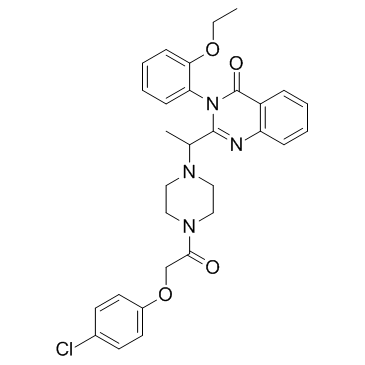571203-78-6
| Name | 2-[1-[4-[2-(4-chlorophenoxy)acetyl]piperazin-1-yl]ethyl]-3-(2-ethoxyphenyl)quinazolin-4-one |
|---|---|
| Synonyms |
2-[1-[4-[2-(4-chlorophenoxy)acetyl]-1-piperazinyl]ethyl]-3-(2-ethoxyphenyl)-4(3H)-Quinazolinone
2-(1-{4-[(4-Chlorophenoxy)acetyl]-1-piperazinyl}ethyl)-3-(2-ethoxyphenyl)-4(3H)-quinazolinone s7242 2-(1-{4-[2-(4-chloro-phenoxy)-acetyl]-piperazin-1-yl}-ethyl)-3-(2-ethoxy-phenyl)-3H-quinazolin-4-one 2-(1-{4-[(4-chlorophenoxy)acetyl]piperazin-1-yl}ethyl)-3-(2-ethoxyphenyl)quinazolin-4(3H)-one 4(3H)-Quinazolinone, 2-[1-[4-[2-(4-chlorophenoxy)acetyl]-1-piperazinyl]ethyl]-3-(2-ethoxyphenyl)- Erastin |
| Description | Erastin is a ferroptosis activator. |
|---|---|
| Related Catalog | |
| In Vitro | Erastin triggers oxidative, iron-dependent cell death. Treatment of NRAS-mutant HT-1080 fibrosarcoma cells with the RSL molecule erastin (10 µM) results in a time-dependent increase in cytosolic and lipid ROS beginning at 2 hours[1]. Cell death triggered by erastin is significantly inhibited by antioxidants (e.g., α-tocopherol, butylated hydroxytoluene, and β-carotene) and iron chelators (e.g., deferoxamine), suggesting that ROS- and iron-dependent signaling is required for erastin-induced ferroptosis. Erastin can directly bind to VDAC2/3 in BJeLR cells. Knockdown of VDAC2 and VDAC3, but not VDAC1, leads to erastin resistance. Erastin has the ability to reduce glutathione level by directly inhibiting cystine/glutamate antiporter system Xc− activity, with activation of the ER stress response[2]. Erastin potently inhibits HT-29 cell survival. Erastin shows a dose-dependent effect, and 30 μM of erastin displays the most dramatic effect[3]. |
| In Vivo | Intraperitoneal injection of erastin at well-tolerated doses dramatically inhibits HT-29 xenograft growth in severe combined immunodeficient mice[3]. |
| Cell Assay | To test erastin’s activity on colorectal cancer cell survival, HT-29 cells are treated with increasing concentrations of erastin (0.1–30 μM). MTT assay was performed[3]. |
| Animal Admin | Mice: Mice are treated daily with 10 or 30 mg/kg body weight of erastin (intraperitoneal injection, for 4 weeks) or vehicle control (Saline). Tumor volumes are calculated. Mice body weights are also recorded every week[3]. |
| References |
[2]. Xie Y, et al. Ferroptosis: process and function. Cell Death Differ. 2016 Mar;23(3):369-79. |
| Density | 1.3±0.1 g/cm3 |
|---|---|
| Boiling Point | 721.9±70.0 °C at 760 mmHg |
| Molecular Formula | C30H31ClN4O4 |
| Molecular Weight | 547.044 |
| Flash Point | 390.4±35.7 °C |
| Exact Mass | 546.203369 |
| PSA | 76.90000 |
| LogP | 4.75 |
| Appearance | white to beige |
| Vapour Pressure | 0.0±2.3 mmHg at 25°C |
| Index of Refraction | 1.634 |
| Storage condition | −20°C |
| Water Solubility | DMSO: soluble5mg/mL, clear (warmed) |
| Symbol |

GHS06 |
|---|---|
| Signal Word | Danger |
| Hazard Statements | H301 |
| Precautionary Statements | P301 + P310 + P330 |
| Personal Protective Equipment | Eyeshields;Faceshields;Gloves;type P2 (EN 143) respirator cartridges |
| Hazard Codes | T |
| Risk Phrases | 25 |
| Safety Phrases | 45 |
| RIDADR | UN 2811 6.1/PG 3 |
